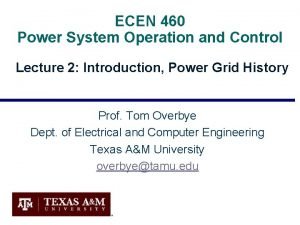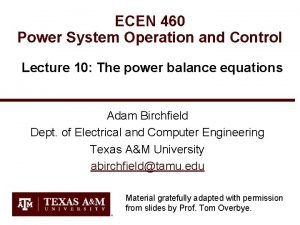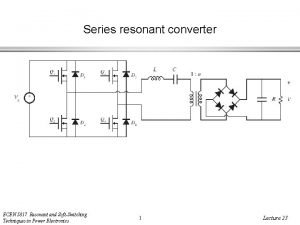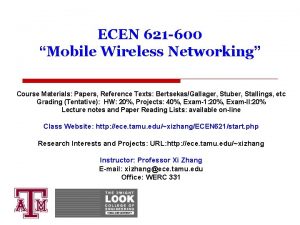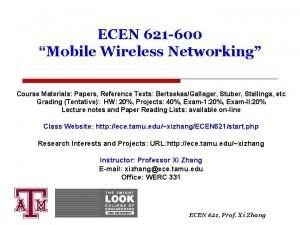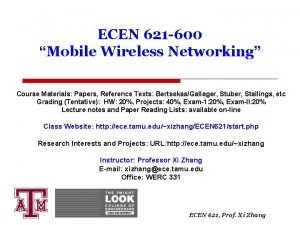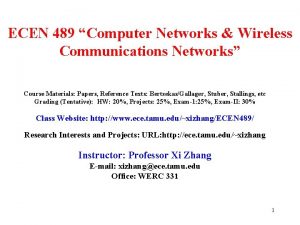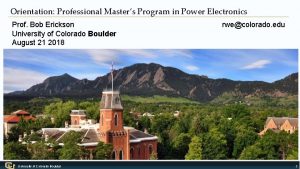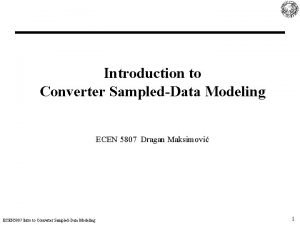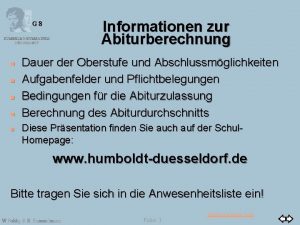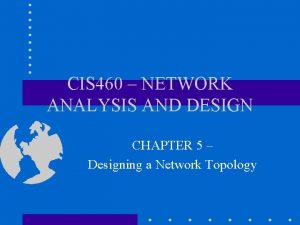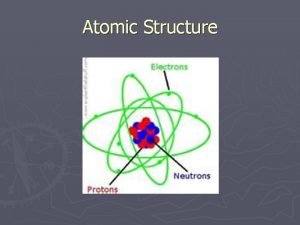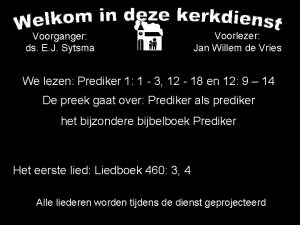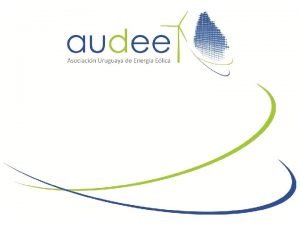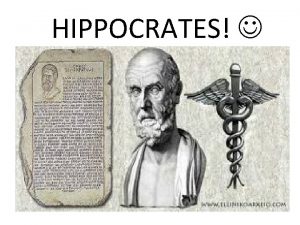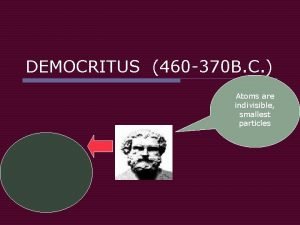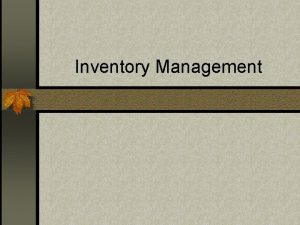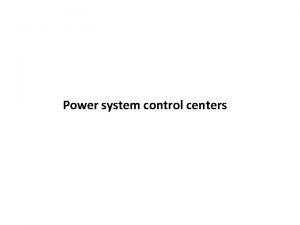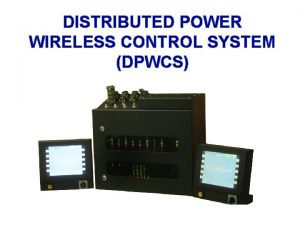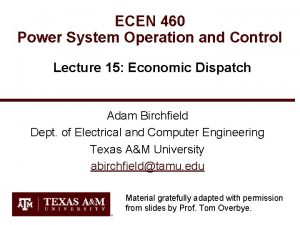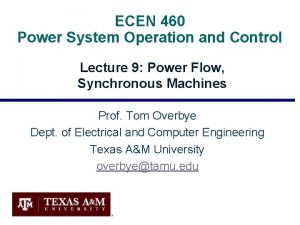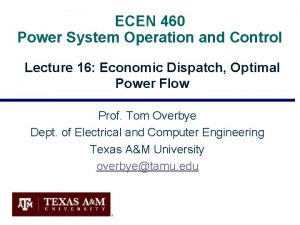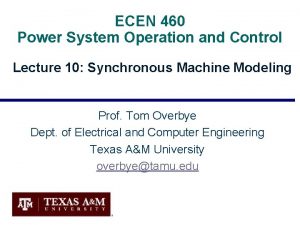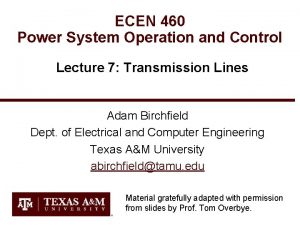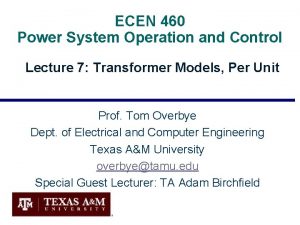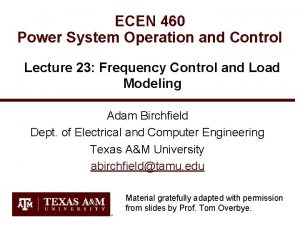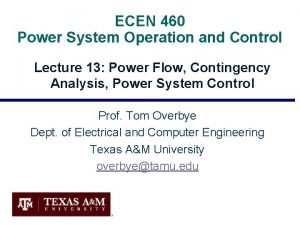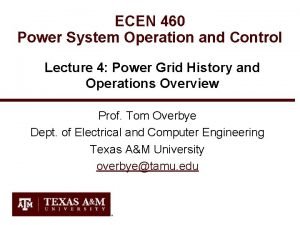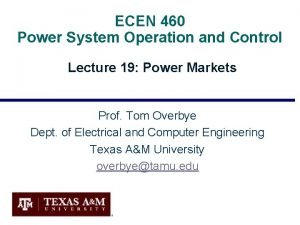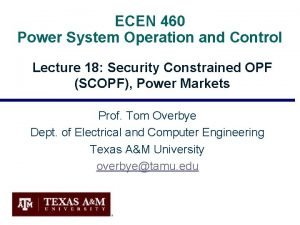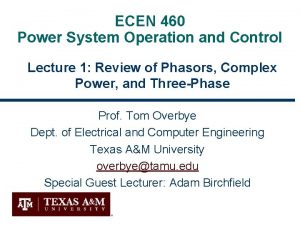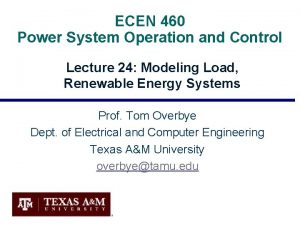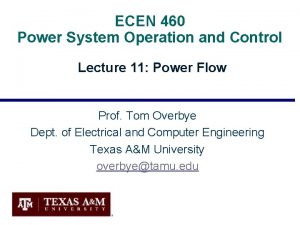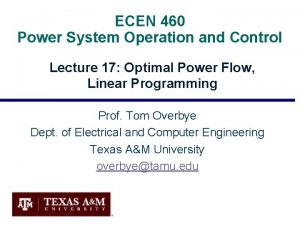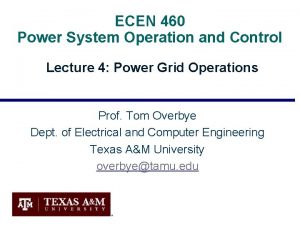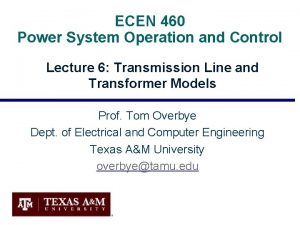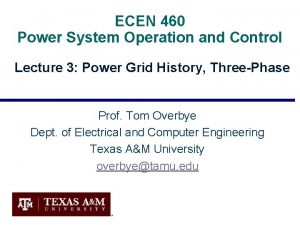ECEN 460 Power System Operation and Control Lecture








































- Slides: 40

ECEN 460 Power System Operation and Control Lecture 23: Frequency Response, Modeling Load Prof. Tom Overbye Dept. of Electrical and Computer Engineering Texas A&M University overbye@tamu. edu

Announcements • Read Chapters 11 and 12 • Design project is due on Dec 5; details on the website • Homework 8 is 11. 12, 11. 18 (part a only), 11. 19, 11. 25, 11. 26; due on Thursday Nov 30 • No labs week of Dec 4 1

August 14, 2003 Timeline Image Sources: August 14, 2003 Blackout Final Report

Control of Generation Overview • Goal is to maintain constant frequency with changing load • If there is just a single generator, such with an emergency generator or isolated system, then an isochronous governor is used – – Integrates frequency error to insure frequency goes back to the desired value Cannot be used with interconnected systems because of "hunting" Image source: Wood/Wollenberg, 2 nd edition 3

Isochronous Gen Example • WSCC 9 bus from before, gen 3 dropping (85 MW) – No infinite bus, gen 1 is modeled with an isochronous generator (PW ISOGov 1 model) Gen 2 is modeled with a TGOV 1 governor Case is wscc_9 bus_ISOGOV 4

Isochronous Gen Example • Graph shows the change in the mechanical output Most of the change in MWs due to the loss of gen 3 is being picked up by gen 1. This would not work in a large system. 5

Droop Control • To allow power sharing between generators the solution is to use what is known as droop control, in which the desired set point frequency is dependent upon the generator’s output R is known as the regulation constant or droop; a typical value is 4 or 5%. At 60 Hz and a 5% droop, each 0. 1 Hz change would change the output by 0. 1/(60*0. 05)= 3. 33% 6

WSCC 9 Bus Droop Example • Assume the previous gen 3 drop contingency (85 MW), and that gens 1 and 2 have ratings of 500 and 250 MVA respectively and governors with a 5% droop. What is the final frequency (assuming no change in load)? 7

WSCC 9 Bus Droop Example • The below graphs compare the mechanical power and generator speed; note the steady-state values match the calculated 59. 66 Hz value Case is wscc_9 bus_TGOV 1 8

WSCC 9 Bus Droop Example: R=0. 01 • Changing to the droop to 0. 01 results in less steadystate frequency error, but at the cost of a faster generator response 9

Quick Interconnect Calculation • When studying a system with many generators, each with the same (or close) droop, then the final frequency deviation is The online generators obviously do not include the contingency generator(s) • The online generator summation should only include generators that actually have governors that can respond, can move in the desired direction, and it does not take into account generators hitting their limits 10

Larger System Example (Prob 6. 11) • As an example, consider the 37 bus, nine generator example from earlier; assume one generator with 42 MW is opened. The total MVA of the remaining generators is 1132. With R=0. 05 Case is Bus 37_TGOV 1 11

Frequency Response Measure Source: wecc. biz/Reliability/Frequency%20 Response%20 Analysis%20 -%20 Dmitry%20 Kosterev. pdf 12

WECC Interconnection Performance Higher values are better! Source: wecc. biz/Reliability/Frequency%20 Response%20 Analysis%20 -%20 Dmitry%20 Kosterev. pdf 13

WECC Interconnect Frequency Response • Data for the four major interconnects is available from NERC; these are the values between points A and B www. nerc. com/pa/RAPA/ri/Pages/Interconnection. Frequency. Response. aspx 14

Eastern Interconnect Frequency Response www. nerc. com/pa/RAPA/ri/Pages/Interconnection. Frequency. Response. aspx 15

ERCOT Frequency Response • As expected, smaller grids have greater frequency sensitivity www. nerc. com/pa/RAPA/ri/Pages/Interconnection. Frequency. Response. aspx 16

Frequency Response Definition • FERC defines in RM 13 -11: “Frequency response is a measure of an Interconnection’s ability to stabilize frequency immediately following the sudden loss of generation or load, and is a critical component of the reliable operation of the Bulk-Power System, particularly during disturbances and recoveries. ” • Design Event for WECC is N-2 (Palo Verde Outage) not to result in under frequency load shed (UFLS) (59. 5 Hz in WECC) • ERCOT requires 5% load shed at 59. 3 Hz, 10% at 58. 9 Hz, and 10% at 58. 5 Hz Source: wecc. biz/Reliability/Frequency%20 Response%20 Analysis%20 -%20 Dmitry%20 Kosterev. pdf 17

ERCOT May 15, 2003 Event • On May 15, 2003 at 2: 54 am both Comanche Peak nuclear units tripped due to breaker failure from a lightning strike – – – Located by Glen Rose, SW of Fort Worth 2275 MW gen tripped immediately, 1146 MW also tripped within seconds, and 775 MW about 43 seconds afterwards System frequency got down to 59. 26 Hz • 471 MW of high-set under frequency load tripped at 59. 7 Hz, and 1549 MW tripped at 59. 3 Image source: ERCOT TAC Meeting, June 4, 2003 Presentation at http: //slideplayer. com/slide/4543302/ 18

2007 CWLP Dallman Accident • In 2007 there was an explosion at the CWLP 86 MW Dallman 1 generator. The explosion was eventually determined to be caused by a sticky valve that prevented the cutoff of steam into the turbine when the generator went off line. So the generator turbine continued to accelerate up to over 6000 rpm (3600 normal). – – – High speed caused parts of the generator to shoot out Hydrogen escaped from the cooling system, and eventually escaped causing the explosion Repairs took about 18 months, costing more than $52 million 19

Dallman After the Accident 20

Outside of Dallman 21

Transient Stability Load Modeling • Load modeling is certainly challenging! • For large system models an aggregate load can consist of many thousands of individual devices • The load is constantly changing, with key diurnal and temperature variations – For example, a higher percentage of lighting load at night, more air conditioner load on hot days • Load model behavior can be quite complex during the low voltages that may occur in transient stability • Testing aggregate load models for extreme conditions is not feasible – we need to wait for disturbances! 22

Transient Stability Load Modeling • Traditionally load models have been divided into two groups – – Static: load is a algebraic function of bus voltage and sometimes frequency Dynamic: load is represented with a dynamic model, with induction motor models the most common • The simplest load model is a static constant impedance – – Has been widely used Allowed the Ybus to be reduced, eliminating essentially all non -generator buses Presents no issues as voltage falls to zero Is rapidly falling out of favor 23

ZIP Load Model • Another common static load model is the ZIP, in which the load is represented as • Some models allow more general voltage dependence 24

ZIP Model Coefficients • An interesting paper on the experimental determination of the ZIP parameters is A. Bokhari, et. al. , "Experimental Determination of the ZIP Coefficients for Modern Residential and Commercial Loads, and Industrial Loads, " IEEE Trans. Power Delivery, 2014 – Presents test results for loads as voltage is varied; also highlights that load behavior changes with newer technologies • Below figure (part of fig 4 of paper), compares real and reactive behavior of light ballast 25

Static Load Model Frequency Dependence • Frequency dependence is sometimes included, to recognize that the load could change with the frequency • Here fk is the per unit bus frequency, which is calculated as A typical value for T is about 0. 02 seconds. • Typical values for Pf and Qf are 1 and -1 respectively 26

Induction Motor Models • Induction motors, both three phase and single phase, make up a very large percentage of the load • Next several slides describe how induction motors are modeled in transient stability – This model would not apply to induction motors controlled by ac drives, since the converter in the drive will make the motor's behavior independent of the source voltage (up to a point); it will look more like a constant power load • Originally invented independently by Galileo Ferraris (1885) and Nikola Tesla (1887) – – Tesla received the US patent in 1888 Key to growth of ac, as opposed to dc, electric systems 27

Induction Machines • Term induction machine is used to indicate either generator or motor; most uses are as motors • Induction machines have two major components – – A stationary stator, which is supplied with an ac voltage; windings in stator create a rotating magnetic field A rotating rotor, in which an ac current is induced (hence the name) • Two basic design types based on rotor design – – Squirrel-cage: rotor consists of shorted conducting bars laid into magnetic material in a cage structure Wound-rotor: rotor has windings similar to stator, with slip rings used to provide external access to the rotor windings 28

Induction Machine Overview • Speed of rotating magnetic field (synchronous speed) depends on number of poles • Frequency of induced currents in rotor depends on frequency difference between the rotating magnetic field and the rotor 29

Induction Machine Slip • Key value is slip, s, defined as • As defined, when operating as a motor an induction machine will have a positive slip, slip is negative when operating as a generator – Slip is zero at synchronous speed, a speed at which no rotor current is induced; s=1 at stand still 30

Basic Induction Machine Model • A basic (single cage) induction machine circuit model is given below – Model is derived in an undergraduate machines class • Circuit describes the static behavior of the machine • Effective rotor resistance (Rr/s) models the rotor electrical losses (Rr) and the mechanical power Rr(1 -s)/s 31

Induction Machine Dynamics • Expressing all values in per unit the mechanical equation for a machine is • Similar to what was done for a synchronous machine, the induction machine can be modeled as an equivalent voltage behind a stator resistance and transient reactance 32

Determining the Initial Values • To determine the initial values, it is important to recognize that for a fixed terminal voltage there is only one independent value: the slip, s – For a fixed slip, the model is just a simple circuit with resistances and reactances • The initial slip is chosen to match the power flow real power value. Then to match the reactive power value (for either a load or a generator), the approach is to add a shunt capacitor in parallel with the induction machine • We'll first consider torque-speed curves, then return to determining the initial slip 33

Torque-Speed Curves • To help understand the behavior of an induction machine it is useful to plot various values as a function of speed (or equivalently, slip) – – – Solve the equivalent circuit for a specified terminal voltage, and varying values of slip Plot results Recall torque times speed = power • – Here speed is the rotor speed When using per unit, the per unit speed is just 1 -s, so PE = TE(1 -s) 34

Induction Motor Example • Assume the below 60 Hz system, with the entire load modeled as a single cage induction motor with per unit values on a 125 MVA base of H=1. 0, Rs=0. 01, Xs=0. 06, Xm=4. 0, Rr=0. 03, Xr=0. 04 – In the CIM 5 model R 1=Rr and X 1=Xr Power. World case B 2_Ind. Motor 35

Induction Motor Example • With a terminal voltage of 0. 995 0 we can solve the circuit for specified values of s • The input impedance and current are • Then with s=1 we get Note, values are per unit on a 125 MVA base 36

Induction Motor Example Torque-Speed Curves • The below graph shows the torque-speed curve for this induction machine; note the high reactive power consumption on starting (which is why the lights may dim when starting a cloth dryer!) From the graph you can see with a 100 MW load (0. 8 pu on the 125 MW base), the slip is about 0. 025 37

Induction Motor Mechanical Load • An induction motor is operating in steady-state when the electrical torque is equal to the mechanical torque • Mechanical torque depends on the type of load – – Usually specified as function of speed, TM=Tbase(wr)m Torque of fans and pumps varies with the square of the speed, conveyors and hoists tend to have a constant torque • Total power supplied to load is equal to torque times speed – Hence the exponent is m+1, with PM=Pbase(wr)m 38

Induction Motor Classes • Four major classes of induction motors, based on application. Key values are starting torque, pull-out torque, full-load torque, and starting current In steady-state the motor will operate on the right side of the curve at the point at which the electrical torque matches the mechanical torque A: Fans, pumps machine tools B: Similar to A C: Compressors, conveyors D: High inertia such as hoists Image source: ecmweb. com/motors/understanding-induction-motor-nameplate-information 39
 Ecen 460
Ecen 460 Ecen 460
Ecen 460 Ecen 5817
Ecen 5817 Ecen 621
Ecen 621 Ecen 621
Ecen 621 Ecen 621
Ecen 621 Ecen 489
Ecen 489 Ecen 5797
Ecen 5797 Ecen 5807
Ecen 5807 Power system dynamics and stability lecture notes
Power system dynamics and stability lecture notes Power system dynamics and stability lecture notes
Power system dynamics and stability lecture notes Power system analysis lecture notes
Power system analysis lecture notes 01:640:244 lecture notes - lecture 15: plat, idah, farad
01:640:244 lecture notes - lecture 15: plat, idah, farad Draw the power triangle
Draw the power triangle Democritus atomic model diagram
Democritus atomic model diagram Hsct moscow
Hsct moscow 460 punkte abitur
460 punkte abitur Rolls royce rental houston
Rolls royce rental houston Cis460
Cis460 Democritus atom model
Democritus atom model Gezang 179
Gezang 179 Historical healthcare figures
Historical healthcare figures 453 en yakın yüzlüğe yuvarlama
453 en yakın yüzlüğe yuvarlama Sen 460
Sen 460 Multis complex shd 460
Multis complex shd 460 St 460 ts
St 460 ts Hippocrates biography
Hippocrates biography Hs 460
Hs 460 Democritus 460 bc
Democritus 460 bc Introduction to inventory management
Introduction to inventory management Power angle curve in power system stability
Power angle curve in power system stability Power semiconductor devices lecture notes
Power semiconductor devices lecture notes Switch mode power supply lecture notes
Switch mode power supply lecture notes Power system control centre
Power system control centre Dpwfs
Dpwfs Control unit operation
Control unit operation System design implementation and operation
System design implementation and operation Solar power satellites and microwave power transmission
Solar power satellites and microwave power transmission Actual power
Actual power Formula for dispersive power of grating
Formula for dispersive power of grating Healthy vs unhealthy relationships
Healthy vs unhealthy relationships
